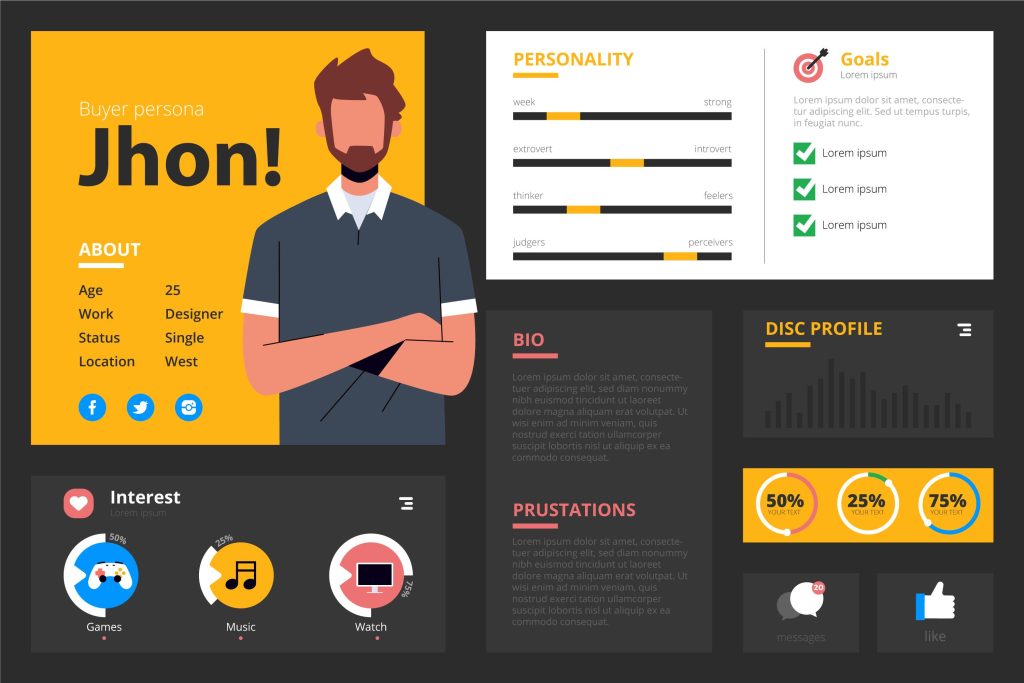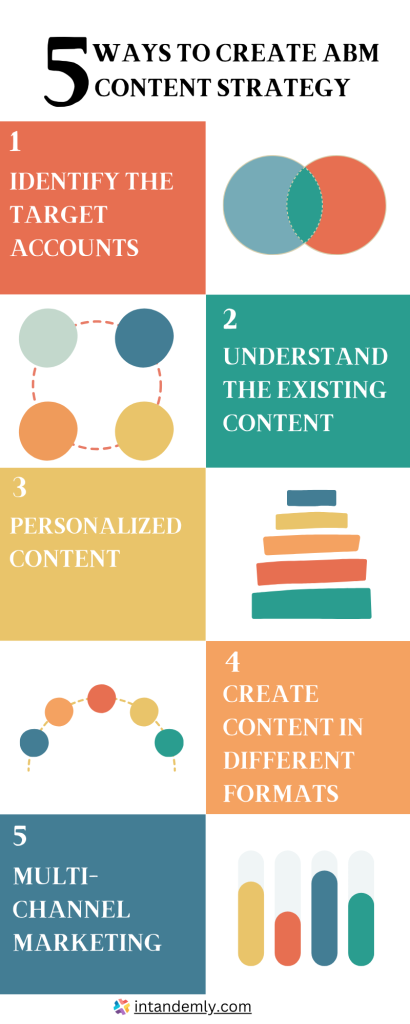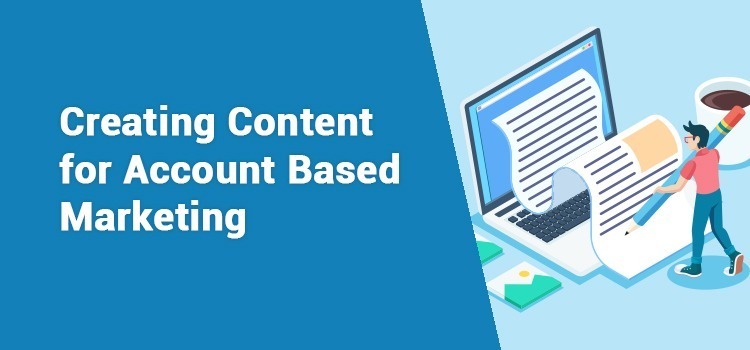5 Ways to Create Right ABM Content Strategy
INTRODUCTION:
Account-Based Marketing (ABM) is a highly effective strategy for targeting and engaging key accounts in the B2B space. One crucial element of any successful ABM campaign is a well-crafted ABM content strategy. Creating content that resonates with your target accounts can help establish credibility, build relationships, and ultimately drive revenue.
ABM Content Strategy is designed to reach a specific set of potential prospects within a target company. Rather than marketing to an individual, campaigns are designed to reach a group of stakeholders and decision-makers within an organization in an orchestrated manner.
Whether you're new to ABM or looking to enhance your existing strategy,this blog post will give you ideas on ways to create the right ABM content strategy,understand the current B2B industry trends and also how to implement these strategies.
What's First?
But it is not just producing more content, you probably have a ton of content already.Quality over quantity any time. Mostly, it’s pointless to send generic broad-based content to your target accounts.
As it involves targeting a specific account, rather than an individual lead,the quality of content required is top notch and highly personalized.
Regardless of your resources, with the help of tricks and tweaks, it is not hard to produce relevant content at scale to support your account based marketing plays.
Here are some ways on how to create personalized, relevant and most importantly scalable content strategies to engage your targeted customers in the ABM process.
Ways to create effective ABM content Strategy
- Doing Enough Research:
To begin, take a close look at your existing customer base and identify the accounts that have provided the most value and growth opportunities. These accounts are likely to have similar characteristics and pain points, making them ideal targets for your ABM strategy.
Additionally, consider the accounts that align with your company's ideal customer profile. These accounts may not be existing customers but have characteristics that make them a good fit for your product or service.
Organizations with a strong Ideal Customer Profile (ICP) -achieve 68% higher account win rates.

Doing account-specific research is recommended to map your content to the accounts, and even the key personas involved in account’s decision making.
For example, if you are targeting healthcare organizations, you can create content that highlights the challenges they face in providing quality patient care and offer solutions that demonstrate how your product or service can help them overcome these challenges. By showcasing real-life examples and success stories, you can make a compelling case for why your target accounts should choose your solution.
ABM relies on close coordination between sales and marketing in order to execute a unified approach to win new businesses and expand on existing business in key accounts.
Marketing and sales teams that take an ABM approach together can be up to 6% more likely to exceed their revenue goals than teams less ABM-advanced
While content creation is all marketing's responsibilities, getting sales input would help in understanding the impactfulness of it, as salespeople know which content works best when it comes to closing the account.
- Understand the existing content:
Producing new content is resource intensive — time & money. Before you start creating brand new and original content, it is highly recommended to understand the existing content.
If you don’t have the list of content details like the date of creation, which audience it was created for and whether it's early, mid or late-stage content etc., it is worth making one.
But if you already have content, conducting a comprehensive audit is very important.
By understanding what content you already have, you can identify gaps and opportunities in your ABM strategy. Analyze which pieces of content align with your target accounts' needs and where there are content deficiencies. This step helps to understand which of your content works, which is obsolete, or which needs an update.
- Personalization:
It is challenging to be scalable, regardless of the team size, thus it is extremely important to have a mix of personalized content strategies.
The buyer's journey consists of three stages: awareness, consideration, and decision. Each stage requires different types of content to effectively guide your target accounts toward making a purchase decision.
During the awareness stage, your content should be focused on building brand awareness and establishing your credibility as a solution provider. This can include educational blog posts, industry reports, and thought leadership articles.
In the consideration stage, your content should provide more detailed information about your product or service and demonstrate how it can solve your target accounts' challenges. This can include case studies, product videos, and webinars.
Lastly, in the decision stage, your content should be focused on persuading your target accounts to choose your offering. This can include testimonials, free trials, and product demos.
It’s not necessary to create fresh content for each stage of the sales funnel from scratch.The best way to scale content personalization is to review your content library and see what can be modified or repurposed to appeal to the intended audience.
For instance, if your target accounts are in the technology sector, you can create content that showcases how your product or service can help them stay ahead of the competition in an ever-evolving digital landscape. Use data and statistics to highlight the specific pain points and challenges faced by technology companies, and offer tailored solutions that address their unique needs. By personalizing your content, you show your target accounts that you understand their specific requirements and can provide them with the right solutions.
Like anything else in marketing, you can profile audience attributes, analyze their behaviors, understand your existing assets, and create a plan, but you must be ready to iterate.
Build a testing process.A/B testing and experimentation are the best way to check if your content is working or impactful.Test different content formats, messaging, and channels to discover what resonates best with your target accounts.
Try something else if a particular visual, message, or asset does not resonate with your target audience at a particular point in their buying journey. The best ABM, including ABM content, adjusts to the needs of your target accounts to ultimately provide the most value.
In a report by Forrester it states that 56% Marketers strongly agree that personalized content is key to ABM success.

- Create Content in different formats:
Diversifying your content format is key to keeping your target accounts engaged.
Different individuals within your target accounts may have different learning styles and preferences when it comes to consuming content. Some might prefer reading, while others may be more inclined to watch videos or engage with interactive content.
By creating content in various forms, you can appeal to a broader audience within your target accounts, increasing engagement and the likelihood of delivering a message that resonates.
Video is a powerful way to engage and inform your target audience. Marketers are using video to create case studies, product demos, and other types of content.72% of B2C marketers expected their organization to invest in video marketing in 2022.
While written articles are excellent, consider incorporating dynamic and interactive content formats. Videos, infographics, or podcasts can communicate complex concepts more effectively and cater to different learning styles. Keep in mind that a diverse content mix ensures you reach and engage various stakeholders within your target accounts, facilitating a comprehensive ABM strategy.
By providing genuine value through your content, you will build trust, credibility, and a loyal following. Remember, your goal is to establish yourself as a trusted advisor who can guide your target accounts towards success.
- Multi channel Marketing:
Once you’ve drafted the content it’s time to distribute it in different marketing channels to your target accounts. Choosing the right channels and formats is crucial for ensuring maximum impact and engagement.
When selecting channels, consider where your target accounts are most likely to consume content. Effective ABM content strategies go beyond a single channel.
This could include email campaigns, social media platforms, industry forums, or even direct mail. It's important to have a multi-channel approach to reach a wider audience and increase your chances of connecting with your target accounts.Multi-channel marketing ensures that your content reaches your target accounts through channels they are actively using.
For example, some prospects may be more responsive to email communications, while others might prefer LinkedIn or Twitter. By being present across multiple channels, you increase the chances of capturing your audience's attention and staying top-of-mind throughout their buyer's journey. Additionally, each channel can serve a unique purpose in nurturing and educating your target accounts, making your ABM strategy more comprehensive and effective.
Incorporating these strategies into your ABM content strategy will enhance your ability to connect with and engage your target accounts effectively.
Remember, the goal of ABM content is to build strong, personalized connections with your target accounts. Keep it simple, informative, and tailored to their needs, and you'll be well on your way to a successful ABM campaign.
95% of marketers say they know how important multichannel marketing is for targeting.
Measuring & Optimizing ABM Content Strategy
Creating a successful ABM content strategy is an ongoing process. It is essential to continuously measure the effectiveness of your content and optimize it based on the insights gathered.
Use analytics tools to track engagement metrics, such as click-through rates, conversion rates, and time spent on page. Analyze the data to identify what content resonates the most with your target accounts and what can be improved. Based on the findings, make data-driven decisions to refine your content strategy and maximize its impact.
Account Engagement: Monitor how actively your target accounts are interacting with your content and outreach efforts.
Time Spent on Page: This metric tracks the amount of time visitors spend on a specific web page or content asset.
Click-Through Rate (CTR): CTR measures the percentage of people who click on a link in your content, such as an email or ad.
Conversion Rate: Measure the percentage of engaged accounts that move through the different stages of your sales funnel.
Pipeline Contribution: Evaluate the value of opportunities generated by your target accounts in comparison to your overall pipeline.
ROI (Return on Investment): Determine the overall return on your ABM investment by comparing the cost of your strategy to the revenue generated.
Customer Retention: Measure the retention rate of target accounts to assess the long-term value they bring to your business.
Account Velocity: Assess how quickly target accounts are progressing from one stage to the next.
These metrics provide a holistic view of your ABM strategy's performance, from engagement and conversion to revenue generation and customer loyalty. By regularly tracking and analyzing these metrics, you can optimize your ABM efforts for maximum impact and success.
For example, if you find that a particular type of content, such as case studies, is generating high engagement and conversion rates, consider creating more of such content. Alternatively, if you find that certain topics or formats are not performing well, adjust your strategy accordingly. By continuously measuring and optimizing your content, you ensure that it remains relevant, effective, and aligned with the changing needs of your target accounts.
In addition, remember to gather feedback from your sales team and your target accounts.Use this feedback to continuously optimize and improve your content strategy to drive better results.
Tips to Create Effective ABM Content Strategy
- Focus on quality over quantity: It is better to create a few high-quality pieces of content than a lot of low-quality content. Make sure that your content is well-written, informative, and relevant to your target audience.
- Use data to drive your content creation.Use AI powered analytical tools to understand your audience,engagement and their behavior. This information will help you to create content that is relevant and adds value.
- Make your content easy to consume: People are busy, so it is important to make your content easy to understand and worth the time. Use short paragraphs, clear headings, and bullet points to make your content easy to scan.
- More interactive content:Marketers are also creating more interactive content, such as quizzes, polls, and calculators. This type of content is more engaging and can help you to generate leads.
CONCLUSION:
To sum up, crafting the right ABM content strategy is crucial for any successful account-based marketing campaign.With a well-executed ABM content strategy in place, you are now ready to deliver impactful content to your target accounts and make the most from the campaigns.
Remember to continuously monitor the performance of your strategy by analyzing key performance indicators, gathering feedback, and making necessary adjustments.
Stay updated with the latest industry trends, embrace technology, and be ready to adapt as the ABM landscape continues to evolve. Your ABM success story awaits!
